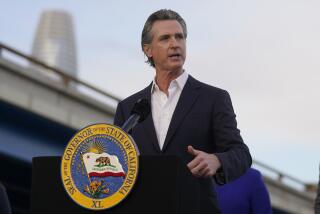Pump price declines may soon reverse
- Share via
Gasoline prices were down this week, but behind the scenes some economists are worried that a jump in the price of crude oil could slow the recovery.
Average pump prices in California fell for the fourth straight week, according to the Energy Department’s weekly survey of filling stations. But with oil futures inching toward $75 a barrel, analysts said the retail gasoline declines may be very short-lived.
Oil futures have bounced between $65 and $75 a barrel for several months, but now it looks as though prices may soon go higher.
That would be bad news for the economy, pushing up the price of gasoline and other products at a time when consumer confidence remains weak and U.S. businesses are continuing to cut jobs, said Edward E. Leamer, director of the UCLA Anderson Forecast.
“It would be like a tax increase, more money out of the wallets and purses of American consumers, and that would tend to stunt any recovery,” he said.
The average price of a gallon of regular gasoline in California fell 5.4 cents over the last week to $3.015, the Energy Department said. Motorists who were willing to shop around today could find it for as low as $2.79 a gallon at various stations in Los Angeles, Orange and Ventura counties, according to GasBuddy.com, a system of websites nationwide where volunteers report the highest and lowest prices they see.
Nationally, pump prices were already rising, by an average of 2.1 cents a gallon to $2.489. Analysts and economists blamed oil prices, which they said could hit $80 to more than $100 a barrel in the coming days and weeks.
On Tuesday, crude oil futures for November delivery rose 88 cents, or 1.2%, to $74.15 a barrel on the New York Mercantile Exchange.
“It could go to $92 a barrel to $102 a barrel pretty easily if it crosses $75 a barrel in trading this week,” said Sean Brodrick, a natural resources analyst for online investment newsletter Uncommon Wisdom.
Brodrick cited several reasons for a potential surge in oil prices. He said investors were fleeing the weak U.S. dollar and pouring their money into gold, oil, silver and other commodities they deemed better investment bets. Burgeoning new-car sales in China are also driving prices as demand for fuel rises.
And although there have been new discoveries of oil, Brodrick said, “it tends to be in very expensive places where it is difficult to find and difficult to get to,” such as BP’s find of a potential billion-barrel field that is thousands of feet below one of the deepest parts of the Gulf of Mexico.
John Kilduff, senior vice president of energy for MF Global, says oil traders have been willing to shrug off weak economic indicators in the U.S. in favor of international evidence of a recovery from the global recession.
“With the dollar still cratering, it looks like there could be support for oil at $80 a barrel to $85 a barrel,” Kilduff said.
The increases could come in spite of a plentiful supply. Phil Flynn, energy analyst for PFG Best in Chicago, said the normal rules of supply and demand do not apply in such a volatile atmosphere.
For consumers, that means higher prices at a time when many are still cutting back. U.S. businesses, meanwhile, are still cutting workers and aren’t likely to start hiring again if consumers reduce spending even further to cope with high gas prices.
“You can’t have sustained economic growth without employment growth,” said UCLA’s Leamer. An oil price surge “adds to the uncertainty. People tend to postpone purchases, and it’s home purchases and auto buying that are needed to power the economy going forward,” he said.
--
More to Read
Inside the business of entertainment
The Wide Shot brings you news, analysis and insights on everything from streaming wars to production — and what it all means for the future.
You may occasionally receive promotional content from the Los Angeles Times.











